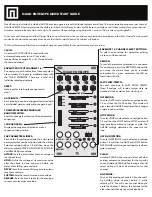
neoVI FIRE 2 User’s Guide
8
© 2016 Intrepid Control Systems, Inc.
Version 2.1 - October 10, 2016
2
A Tour of neoVI FIRE2 Hardware
Let’s now take a short tour of the neoVI FIRE 2’s hardware. We’ll examine the device from
all sides, showing its external components and explaining what each does. This will help you
become more familiar with the unit so you can more easily set up, configure and use it.
Like many Intrepid products, the neoVI FIRE 2 is designed so that all of its connectors are
located on its sides, making the device easier to use in cramped quarters. We’ll refer to these
as the
left side
and
right side
of the unit, as oriented when facing the device with its top label
text readable.
Warning:
The neoVI FIRE 2 is a complex device that does not
contain any user-serviceable parts. Do not attempt to open the
case of the neoVI FIRE 2 unless specifically instructed to do so by
an Intrepid Control Systems technician, or you risk possible injury
or damage to the unit.
2.1 Case and Overall Design
The neoVI FIRE 2 is enclosed in a sturdy black-anodized metal case. The device has been
designed and tested for in-vehicle use, and is operational in a temperature range from -40°C to
+85°C. An overall view of the neoVI FIRE 2 can be seen in Figure 3.
Connectors and ports are often a point of failure with hardware devices. To ensure that the
neoVI FIRE 2 provides you with years of reliable service, Intrepid has ruggedized the physical
interfaces on the device by using reinforced metal connectors.
To further protect the device against bumps and drops, it has cyan-colored rubber bumpers
on both ends. These bumpers are removable, but there is no need to do this under normal
circumstances, and we recommend that you leave them in place.













































